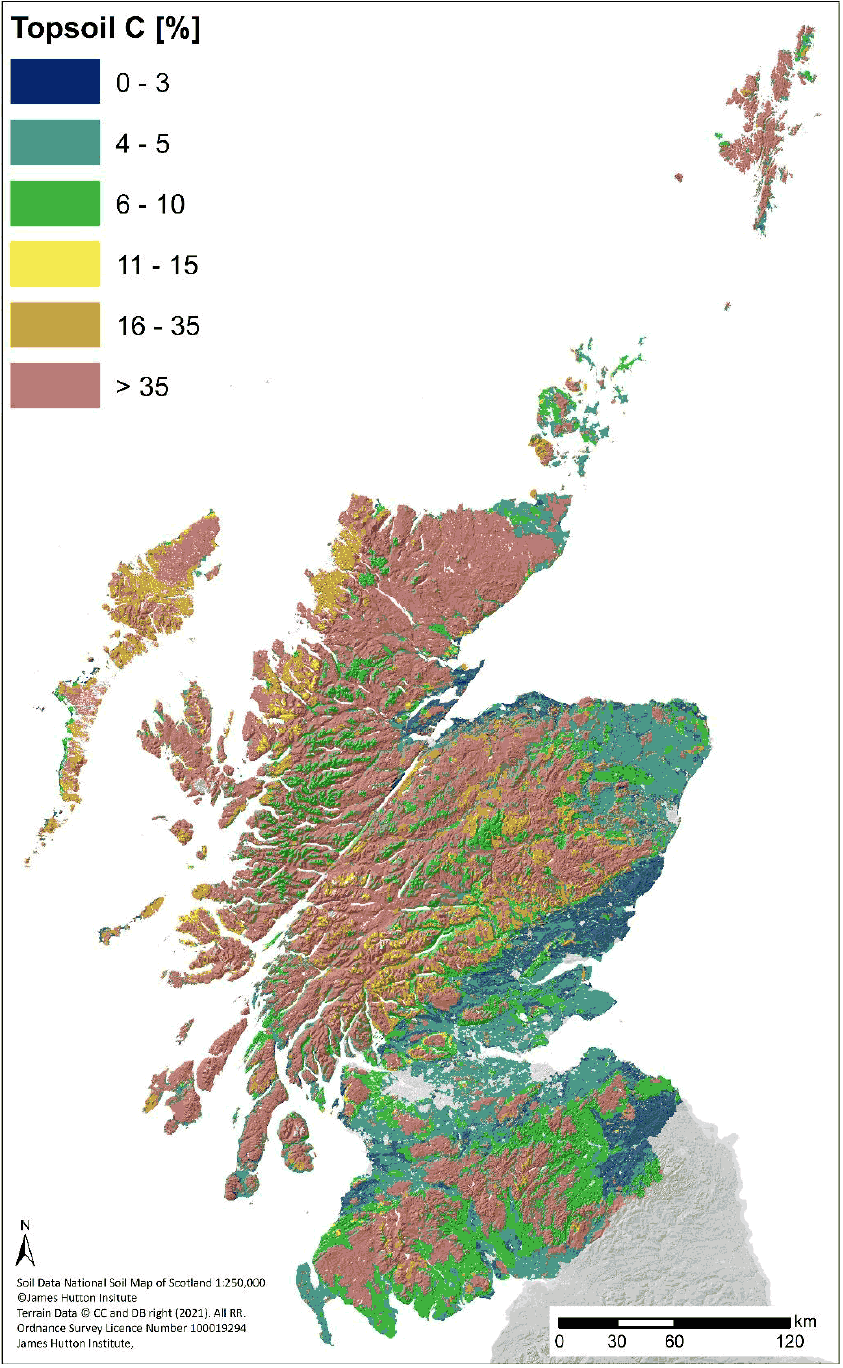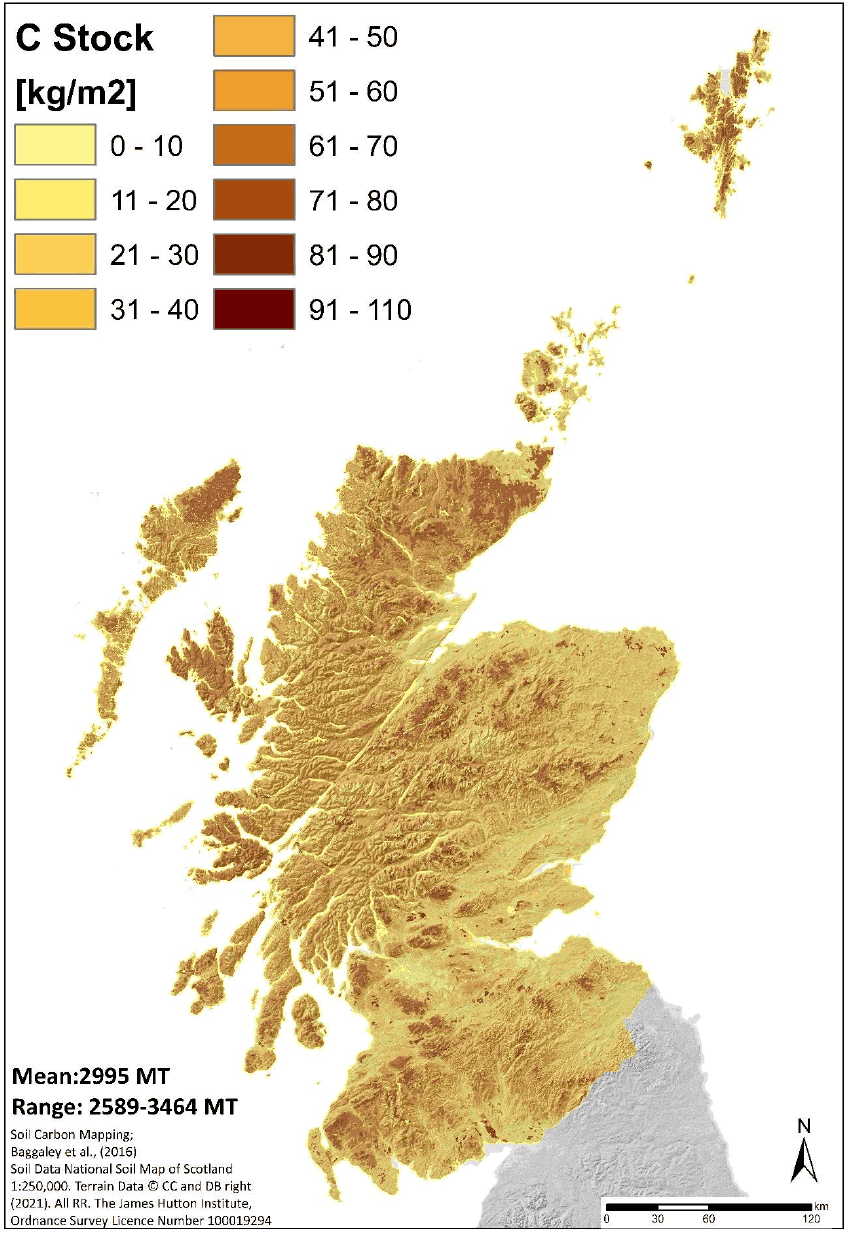Soil organic carbon sequestration: scoping study
A report evaluating the ability of existing datasets to answer questions regarding the status of organic carbon in Scottish soils.
1 Executive summary
This report sets out to critically evaluate the ability of existing datasets to answer a series of questions regarding the status of organic carbon in Scottish soils; how much is there and where, how it is affected by specific land uses, has it changed over time and what is the potential for Scotland’s soils to gain or lose carbon.
Soil organic matter (SOM) is derived from the breakdown of leaf litter, dead roots, plant material and animal waste. If the rate of accumulation is greater than the rate of decomposition, then the amount of SOM in the soil increases. However, when decomposition rates exceed the accumulation rate, then greenhouse gases such as carbon dioxide and methane are released and the amount of soil carbon declines.
Soil organic carbon (SOC) is a component of SOM along with other elements such as nitrogen, phosphorous, potassium and calcium. It is usual to measure SOC and convert the value to SOM using a conversion factor that assumes that SOC comprises around 58% of SOM. Loss on ignition (LoI), where a soil sample is burnt in a furnace, is often used as a surrogate of SOM but the loss on ignition value can vary depending on furnace temperature.
Thirty-seven datasets with organic carbon measurements in Scottish soils have been identified. Many have data on soil organic carbon concentrations, but few have data on the quantity (stock) of soil organic carbon. Few of these datasets were specifically designed to quantify soil organic carbon concentrations, stocks or changes over time.
How much carbon is stored in Scottish soils and where is it?
The total stock of soil organic carbon to 100 cm depth in Scottish soils is estimated to be around 3000 Mt C. However, previous analytical methods may have over-estimated soil organic carbon concentrations.
The distribution of soil organic carbon concentrations and stocks have been mapped with examples shown below. The maps give an overview of where the high and low soil organic carbon contents are. The lowest SOC concentrations and stocks are found mainly in the eastern lowlands while the greatest concentrations and stocks are in uplands. Some of these maps can also be viewed online (https://om.hutton.ac.uk/) where they can be queried in more detail, however, the maps are produced at fixed scales and zooming-in does not change the resolution of the map.
How much carbon is stored in soils under different land uses (specifically arable, rotational grassland, permanent grassland and upland semi-natural land)?
Evidence from several datasets shows the least soil organic carbon concentrations in cultivated land are in arable land, followed by land under rotational grassland and then land under permanent or long ley pasture. The same soil types occur in each of these three land use categories suggesting that land use is a key driver of the difference but factors that predispose an area to a particular land use may have a role.
Often the land use at the time of sampling is recorded but land management or land use history are rarely recoded in the datasets. Therefore, only in some cases can soil organic carbon contents be related to land use histories such as the length of time since last ploughed or since the last application of organic fertilisers or since sown to grass. Coupling the Integrated Administration and Control System (IACS) land use data with recent soil organic carbon data could help improve our understanding of some of these factors such as the effect on soil organic carbon contents by including grassland in an arable rotation.
A national scale resampling programme in 2007-9 sampled soils at around 180 locations throughout Scotland and showed that upland or semi-natural soils store more soil organic carbon per hectare than lowland soils. Peatlands have the greatest stocks followed by moorland soils, woodland and then semi-natural grasslands.
| Land cover | Carbon t ha-1 |
|---|---|
| Arable | 112 |
| Improved grassland | 138 |
| Semi-natural grassland | 185 |
| Woodland | 268 |
| Moorland | 291 |
| Peatland/Bog | 528 |
How has Scotland’s soil carbon content changed over time?
The national scale resampling programme in 2007-9 sampled soils at around 180 locations that had been sampled between 20 and 30 years previously. The carbon stocks over the top 100cm of soil were calculated at each location were grouped by land cover. The only land cover type to show an increase in soil organic carbon stocks was woodland, while the soils under arable, improved grassland, semi-natural grassland, moorland and bog showed no statistically significant change.
However, the changes observed in soil organic carbon stocks or topsoil concentrations in Scottish soils over time are not straightforward with some datasets showing no change whilst others show a decline in concentration but no statistically significant change in stocks.
While measurements of soil organic matter concentration are useful and relatively straightforward, measuring soil organic carbon stocks over the full thickness of the soil is a more robust method to assess change as this also takes account of potential changes in depth and density as well as concentration.
Few datasets were collected specifically to investigate change in SOC over time, but it is possible that many could be adapted to give rapid, interim measures of change and help establish suitable sampling densities for any potential monitoring schemes if a clear set of protocols could be developed.
What is the potential for Scotland’s soils to gain or lose carbon and what are the likely land use drivers of this change?
It is estimated that there was the potential to store an additional 60 Mt C in Scottish topsoils under grassland soils and 88 Mt C in topsoils under arable land but there was also the risk that up to 112 Mt C of stored soils organic carbon could be lost. However, Scottish soils generally have high soil organic carbon contents and, as the annual rate of carbon accumulation declines as concentrations increase, it may be difficult to further increase the carbon content of Scottish soils under current land use practices.
While there is a considerable body of literature quantifying rates of soil organic carbon accumulation, very few are specific to Scottish conditions and only a few for the UK. Suggested management methods to increase SOC include reduced or no tillage, increased residue returns, fertilising and liming, crop rotation, adding organic manures, growing catch crops and changes in grazing intensity; many which are already practiced.
Land use change is one of the main drivers of soil organic carbon losses. Evidence from the scientific literature shows that changes from semi-natural land to improved grassland and from pasture to arable lead to a loss of soil organic carbon. This is supported by various studies that show soil organic carbon stocks or concentrations are lesser in soils under arable land compared to soils under pasture and in soils under pasture compared to those under semi-natural vegetation. There is less evidence available in the literature to assess the effects of land management on soil organic carbon losses.
Increasing soil organic carbon concentration in soils has multi-benefits besides sequestering carbon to offset greenhouse gas emissions. Soil organic carbon promotes and maintains good soil structure, nutrient retention and soil biodiversity. An improved soil structure allows water infiltration reducing runoff and flooding while retaining sufficient water for crop growth.


Contact
There is a problem
Thanks for your feedback